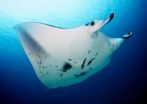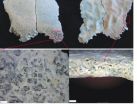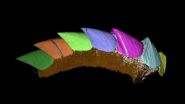(Press-News.org) An unexpected discovery by astronomers using the National Science Foundation's Karl G. Jansky Very Large Array (VLA) is forcing scientists to rethink their understanding of the environment in globular star clusters, tight-knit collections containing hundreds of thousands of stars.
The astronomers used the VLA to study a globular cluster called Messier 22 (M22), a group of stars more than 10,000 light-years from Earth. They hoped to find evidence for a rare type of black hole in the cluster's center. They wanted to find what scientists call an intermediate-mass black hole, more massive than those a few or more times the Sun's mass, but smaller than the supermassive black holes found at the cores of galaxies.
"We didn't find what we were looking for, but instead found something very surprising -- two smaller black holes," said Laura Chomiuk, of Michigan State University and the National Radio Astronomy Observatory. "That's surprising because most theorists said there should be at most one black hole in the cluster," she added.
Black holes, concentrations of mass so dense that not even light can escape them, are left over after very massive stars have exploded as supernovae. In a globular cluster, many of these stellar-mass black holes probably were produced early in the cluster's 12-billion-year history as massive stars rapidly passed through their life cycles.
Simulations have indicated that these black holes would fall toward the center of the cluster, then begin a violent gravitational dance with each other, in which all of them or perhaps all but a single one would be thrown completely out of the cluster.
"There is supposed to be only one survivor possible," said Jay Strader, of Michigan State University and the Harvard-Smithsonian Center for Astrophysics. "Finding two black holes, instead of one, in this globular cluster definitely changes the picture," he said.
The astronomers suggest some possible explanations. First, the black holes themselves may gradually work to puff up the central parts of the cluster, reducing the density and thus the rate at which black holes eject each other through their gravitational dance. Alternatively, the cluster may not be as far along in the process of contracting as previously thought, again reducing the density of the core.
"Future VLA observations will help us learn about the ultimate fate of black holes in globular clusters," Chomiuk said.
The two black holes discovered with the VLA were the first stellar-mass black holes to be found in any globular cluster in our own Milky Way Galaxy, and also are the first found by radio, instead of X-ray, observations.
###
Chomiuk and Strader worked with Thomas Maccarone of the University of Southampton in the U.K., James Miller-Jones, of the International Centre for Radio Astronomy Research at Curtin University in Australia, and Anil Seth of the University of Utah. The scientists published their findings in the October 4 issue of the scientific journal Nature.
The National Radio Astronomy Observatory is a facility of the National Science Foundation, operated under cooperative agreement by Associated Universities, Inc.
Surprising black-hole discovery changes picture of globular star clusters
Scientists rethinking their understanding of environment in close clusters of hundereds of thousands of stars
2012-10-04
ELSE PRESS RELEASES FROM THIS DATE:
50-hour whole genome sequencing provides rapid diagnosis for children with genetic disorders
2012-10-04
KANSAS CITY, Mo. – OCTOBER 3, 2012 – Today investigators at Children's Mercy Hospitals and Clinics in Kansas City reported the first use of whole genome information for diagnosing critically ill infants. As reported in Science Translational Medicine, the team describes STAT-Seq, a whole genome sequencing approach - from blood sample to returning results to a physician - in about 50 hours. Currently, testing even a single gene takes six weeks or more.
Speed of diagnosis is most critical in acute care situations, as in a neonatal intensive care unit (NICU), where medical ...
Key environmental factors influencing manta ray behavior identified
2012-10-04
Manta rays are more likely to gather together under either a new or a full moon, according to new research published Oct 3 in the open access journal PLOS ONE by Fabrice Jaine and colleagues at the University of Queensland.
The research identifies environmental factors that predict the abundance and behavior of manta rays at Lady Elliott Island in the Great Barrier Reef. The authors comment that knowing these factors is important for conservation efforts, "especially in the context of a changing climate and with targeted fisheries increasingly threatening manta ray populations ...
Oldest evidence of regular meat consumption by early humans found
2012-10-04
A fragment of a child's skull discovered at Olduvai Gorge, Tanzania shows the oldest known evidence of anemia caused by a nutritional deficiency, reports a new paper published Oct. 3 in the open access journal PLOS ONE.
The discovery, made by a global team of researchers led by Manuel Domínguez-Rodrigo from Complutense University, Madrid, suggests that early human ancestors began eating meat much earlier in history than previously believed. The skull fragment identified is thought to belong to a child somewhat younger than two and shows bone lesions that commonly result ...
Novel blood-based protein signature determined for rare, aggressive lung cancer
2012-10-04
Researchers have discovered a panel of 13 blood proteins that may be effective biomarkers to detect malignant mesothelioma, according to a study published Oct. 3 in the open access journal PLOS ONE by Rachel Ostroff from the company SomaLogic, which developed the new test, and colleagues at other institutions.
Malignant mesothelioma is a rare, aggressive form of lung cancer that can develop after prolonged exposure to asbestos. Because early diagnosis is difficult, most patients face a poor prognosis and have few options for treatment. In the study, authors compared proteins ...
Less is more when choosing between groups of assorted items
2012-10-04
When making decisions about the value of an assortment of different objects, people approximate an average overall value, which though frequently useful can lead to apparently irrational decision-making. A new study published Oct 3 in PLOS ONE by Jerald Kralik and colleagues at Dartmouth College shows for the first time that non-human primates also make similar 'irrational' choices based on approximation.
In the study, researchers found that rhesus monkeys preferred a highly-valued food item (a fruit) alone to the identical item paired with a food of positive but lower ...
Mollusc missing link revealed in 3-D
2012-10-04
Scientists have discovered a rare fossil called Kulindroplax, the missing link between two mollusc groups, which is revealed in a 3D computer model, in research published today in the journal Nature.
The researchers have unearthed the worm-like partly shelled Kulindroplax, which they have modelled in a 3D computer animation. Kulindroplax lived in the sea during the Silurian Period, approximately 425 million years ago, when most life lived in the oceans and the first plants were beginning to grow on land. The team found the Kulindroplax fossil, the only one of its kind ...
Blocking tumor-induced inflammation impacts cancer development
2012-10-04
Researchers at the University of California, San Diego School of Medicine report the discovery of microbial–dependent mechanisms through which some cancers mount an inflammatory response that fuels their development and growth.
The findings are published in the October 3, 2012 Advanced Online Edition of Nature.
The association between chronic inflammation and tumor development has long been known from the early work of German pathologist Rudolph Virchow. Harvard University pathologist Harold Dvorak later compared tumors with "wounds that never heal," noting the similarities ...
Healthcare professionals as bad as patients at good respiratory inhaler technique
2012-10-04
Healthcare professionals are as bad as patients when it comes to knowing how to use inhalers prescribed for asthma and other respiratory conditions correctly, says an editorial in Drug and Therapeutics Bulletin (DTB).
They therefore can't be relied on to teach patients how to use these devices correctly, says DTB.
But as 45 million prescriptions for respiratory inhalers were dispensed in 2011 in England alone—at a cost of £900 million to the NHS—everyone needs to be more clued up on correct inhaler technique to make sure these drugs work well for patients and offer ...
Aspirin may temper brain power decline in elderly women at risk of heart disease
2012-10-04
Daily low dose aspirin could slow the decline in brain power among elderly women at high risk of heart disease, indicates observational research published in the online journal BMJ Open.
The researchers base their findings on 681 women between the ages of 70 and 92, 601 of whom were at high risk of heart disease and stroke, defined as a 10% or greater risk on a validated risk scale (Framingham).
All the women were subjected to a battery of tests to measure their physical health and intellectual capacity, including verbal fluency and memory speed, and dementia (mini ...
Ancient mollusk tells a contrary story
2012-10-04
New Haven, Conn. — A fossil unearthed in Great Britain may end a long-running debate about the mollusks, one of life's most diverse invertebrate groups: Which evolved first, shelled forms like clams and snails, or their shell-less, worm-like relatives?
The small new fossil, found in marine rocks along the English-Welsh border, provides the best fossil evidence yet that the simpler worm-like mollusks evolved from their more anatomically complex shelled brethren, rather than the other way around.
The discovery reinforces previous findings from molecular sequencing studies ...
LAST 30 PRESS RELEASES:
Oldest modern shark mega-predator swam off Australia during the age of dinosaurs
Scientists unveil mechanism behind greener ammonia production
Sharper, straighter, stiffer, stronger: Male green hermit hummingbirds have bills evolved for fighting
Nationwide awards honor local students and school leaders championing heart, brain health
Epigenetic changes regulate gene expression, but what regulates epigenetics?
Nasal drops fight brain tumors noninvasively
Okayama University of Science Ranked in the “THE World University Rankings 2026” for the Second Consecutive Year
New study looks at (rainforest) tea leaves to predict fate of tropical forests
When trade routes shift, so do clouds: Florida State University researchers uncover ripple effects of new global shipping regulations
Kennesaw State assistant professor receives grant to improve shelf life of peptide- and protein-based drugs
Current heart attack screening tools are not optimal and fail to identify half the people who are at risk
LJI scientists discover how T cells transform to defend our organs
Brain circuit controlling compulsive behavior mapped
Atoms passing through walls: Quantum tunneling of hydrogen within palladium crystal
Observing quantum footballs blown up by laser kicks
Immune cells ‘caught in the act’ could spur earlier detection and prevention of Type 1 Diabetes
New membrane sets record for separating hydrogen from CO2
Recharging the powerhouse of the cell
University of Minnesota research finds reducing inflammation may protect against early AMD-like vision loss
A mulching film that protects plants without pesticides or plastics
New study highlights key findings on lung cancer surveillance rates
Uniform reference system for lightweight construction methods
Improve diet and increase physical activity at the same time to limit weight gain, study suggests
A surprising insight may put a charge into faster muscle injury repair
Scientists uncover how COVID-19 variants outsmart the immune system
Some children’s tantrums can be seen in the brain, new study finds
Development of 1-Wh-class stacked lithium-air cells
UVA, military researchers seek better ways to identify, treat blast-related brain injuries
AMS Science Preview: Railways and cyclones; pinned clouds; weather warnings in wartime
Scientists identify a molecular switch to a painful side effect of chemotherapy
[Press-News.org] Surprising black-hole discovery changes picture of globular star clustersScientists rethinking their understanding of environment in close clusters of hundereds of thousands of stars




